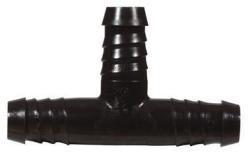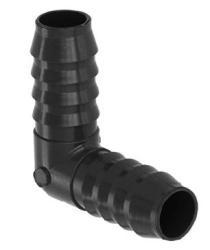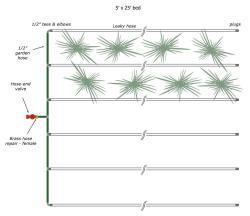Sorry for the delay, It's been a busy week, plus we spent a day picking up a new puppy, so there's been no time until this morning to put this together.
The final pieces to the system are plastic 1/2" barbed hose connectors. I get these from the local hardware store—I think they're designed for use with black 1/2" flexible pipe, (I think it's ABS?) and possibly intended for sprinkler systems. Tees, elbows and end-plugs are the pieces you'll need. The only images I could find are of black fittings, but the ones I buy are gray. The fittings pictured were very expensive on Amazon, but reasonable if purchased locally. Quite a few items are that way.


Because the leaky hose is fairly soft, I like to use stainless steel safety wire instead of hose clamps for all of the leaky hose connections.
https://www.amazon.com/dp/B005SUWZAU/
Scrap pieces of 1/2" garden hose can be used in the manifold and delivery system everywhere you don't want or need to water. Garden hose is stiff and needs a hose clamp, light-duty clamps can be used on the low-pressure side of the system, which is anywhere downstream of the hose-end valve.
The setup for a 5' x 25' garden bed would be something like this.

This layout shows lines spaced a foot apart, and assumes a fairly heavy soil. Drip systems of any type are rarely suitable for sandy, or very fast draining soils. The perimeter lines should be run around 6-8" from the base of the plants, so that a wide-ranging root system develops. The idea is to supply moisture as uniformly as possible to the entire bed and 'drip line' of the plants.
To put the system into service, close the hose-end valve, hook up the water supply and turn on the faucet. The leaky hose lines will be full of air, so open the hose-end valve slowly, but fairly generously at first, until you see that the leaky hose is dripping or spraying water throughout its length. You can sometimes tell by ear when the air is expelled because the water flow slows. There will be some fine sprays of water shooting up here and there, by watching those, you are able to tune the water flow. I usually adjust the hose end valve so that those sprays are around 3-4 inches, or less. That way the hose weeps nicely throughout its length. I have put a pressure gauge in the system when it's running this way and it's always less than 10 psi. It's very dry here in the summer, so every few weeks I'd hit the beds by hand with a spray wand, concentrating on the underside of the foliage in order to keep spider mites under control. This also helps wet any dry areas that may develop in the beds.
For longer runs such as an 8' x 40' bed, first determine that your water supply can keep up with that much leaky hose, then build the "supply manifold" at the middle of the bed and run water through 20' runs in each direction. If your water supply is inadequate, the 40' bed can be split into two zones.
The leaky hose will last much longer if it's covered. I used a mulch. The manufacturer suggests burying it, but I've never tried that. Rodents may chew on it for the moisture, rabbits will do it just for fun. Damaged hose can be repaired with a male-male barbed fitting and a couple of twists of wire.


